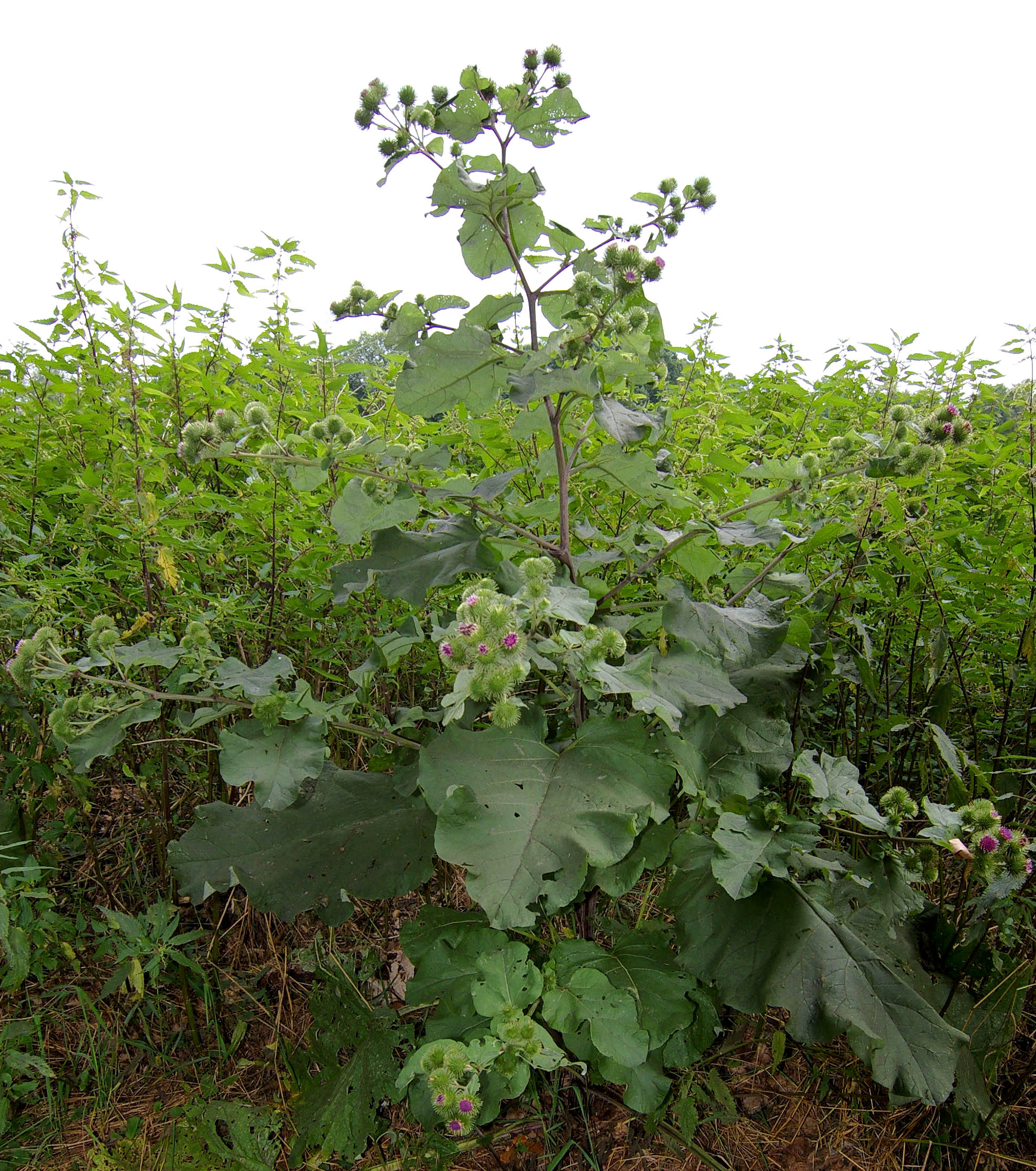- Greater burdock
Taxobox
name = Burdock

image_width = 250px
image_caption = Greater Burdock
regnum =Plant ae
divisio = Magnoliophyta
classis =Magnoliopsida
ordo =Asterales
familia =Asteraceae
genus = "Arctium "
species = "A. lappa"
binomial = "Arctium lappa"
binomial_authority = L.Greater burdock, Edible burdock, or Lappa Burdock is a
biennial plant of the "Arctium" (burdock )genus in theAsteraceae family, cultivated in gardens for its root used as avegetable .Description
Greater Burdock is rather tall, reaching as much as 2 metres. It has large, alternating, cordiform leaves that have a long petiole and are pubescent on the underside.
The flowers are purple and grouped in globular capitula, united in clusters. They appear in mid-summer.The capitula are surrounded by an
involucre made out of manybract s, each curving to form a hook, allowing them to be carried long distances on the fur of animals. The fruits areachene s; they are long, compressed, with short pappuses.The fleshy tap-root reaches a length of 50 cm.
Origin and distribution
This species is native to the temperate regions of the old world, from
Scandinavia to theMediterranean , and from theBritish Isles throughRussia , and theMiddle East toChina andJapan , includingIndia . It is naturalized almost everywhere and is usually found in disturbed areas, especially in soil rich in nitrogen. It is commonly cultivated in Japan where it gives its name to a particular construction technique,burdock piling .Cultivation
It prefers a fresh, worked soil, rich in humus, and should be positioned in full sunlight. Burdock is very reactive to nitrogen fertilizer. Propagation is achieved through direct sowing the seeds midsummer. The harvest occurs three to four months after the seeding until late autumn, when the roots become too fibrous.
Culinary use
Greater burdock was used during the
Middle Ages as a vegetable, but now it is rarely used, with the exception of Japan where is called "gobō" (牛蒡 or ゴボウ), Korea where is is called "ueong" (우엉),Italy , andPortugal , where it is known as "bardana". Plants are cultivated for their slender roots, which can grow about 1 meter long and 2 cm across.Immature flower stalks may also be harvested in late spring, before flowers appear. The taste resembles that of
artichoke , to which the burdock is related.In the second half of the 20th century, burdock achieved international recognition for its culinary use due to the increasing popularity of the
macrobiotic diet , which advocates its consumption. The root contains a fair amount of gobōdietary fiber (GDF, 6g per 100g), calcium, potassium, amino acids, [http://www.nikkeibp.co.jp/wcs/leaf/CID/onair/kenkou/plus/419412] and is low calorie. It containspolyphenol s that causes darkened surface and muddy harshness by formation oftannin -iron complexes.The root is very crisp and has a sweet, mild, and pungent flavor with a little muddy harshness that can be reduced by soaking julienned/shredded roots in water for five to ten minutes. The harshness shows excellent harmonization with pork in miso soup (
tonjiru ) andtakikomi gohan (a Japanese-stylepilaf ).A popular Japanese dish is "
kinpira gobō", julienned or shredded burdock root and carrot, braised with soy sauce, sugar, mirin and/or sake, and sesame oil. Another is burdock makizushi (rolled sushi filled with pickled burdock root; the burdock root is often artificially colored orange to resemble a carrot). InKyoto , gobō can also be found as a snack food similar topotato chips . The root is eaten cooked and the young sprout can be eaten just likeasparagus .Use in traditional medicine
Folk herbalists consider dried burdock to be a
diuretic ,diaphoretic , and ablood purifying agent. The seeds of greater burdock are used intraditional Chinese medicine , under the name "niupangzi" (zh-cp|c=牛蒡子|p=niúpángzi; some dictionaries list the Chinese as just 牛蒡 niúbàng.)External links
Wikimedia Foundation. 2010.
